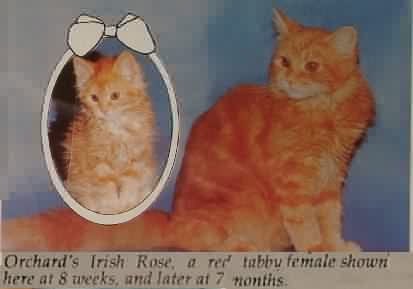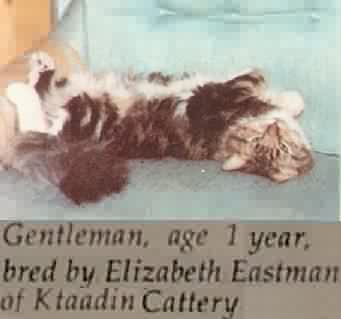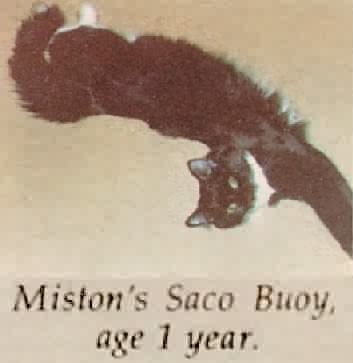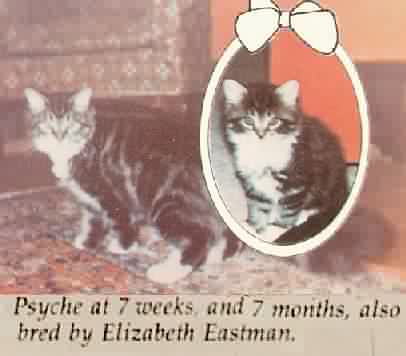| YANKEE December 1976, blz 88 Maine Coon Cats Are Back |
Maine Coon Cats Are Back
The Persian, Siamese, Manx and other imported breeds have dominated the interest of cat fanciers since the turn of the century. But this year, thanks to the long, hard work of his dedicated partisans, the Maine Coon -America’s first show cat and the only native American domestic feline- is once again an officially recognized breed ….
by Marilis Hornidge
LADIES AND GENTLEMAN: Presenting the only Native American Domestic Feline … the Maine coon cat.
Would you believe a cross between a raccoon and a house cat? How about a chivalrous sea captain whose plan to save a queen failed, but who instead brought to his hometown in Maine a royal breed of feline? Or another New England sea captain named Coon who imported exotic kittens from the orient?
The origins of the Maine coon cat are so befurred by legend as to be untraceable, even by afficionados. The main point (if the unavoidable pun may be overlooked) on which there is agreement is that it was the first show cat in America. Although breeding records were not kept at the time, these cats are mentioned in private documents as show breed as far back as the early 1860s. In F.R. Pierce’s The Book of the Cat, there is mention of Leo, a tabby Maine coon who won the Best Cat award in the New York City show of 1895 and was a consistent winner in the Boston shows until 1900, when he was deposed by his son. Pierce also mentions that in 1861 he and his brother owned a black Maine coon with the euphonious name of Captain Jenks of the Horse Marines, who thus gains the distinction of being the earliest named Maine coon of record. The first volume of C.F.A. (Cat Fancy of America) registry included 28 Maine coon cats.

Orchard’s Irish Rose
After the turn of the century, however, the fickle fancy of feline fashion turned to imported cats with long pedigrees and exotic physiognomies such as Persians, Siamese and Manx. These status cats became the piece de resistance of cat breeders and therefore of shows. After 1904, the Maine coon dropped out of the public eye except, natuyrally enough, in his native state.
People in Maine are quietly stubborn about their opinions, particularly on the superiority of native products, and are not likely to be swayed by current vogue. In the early 1950s the Central Maine Cat Club was organized to provide shows in which Maine coons could be judged, develop standards and a registry for the breed, and to work for their recognition by show-sponsoring organizations. By 1960 there were several groups working more or less together to arrive at a realistic standard which would be acceptable to the fancy – a generic term which covers all organizations that register and sponsor shows for cats. A difficulty faced by American cat breeders, which is avoided by their canine counterparts, is that there is no single central organization comparable to the A.K.C. Instead there are nine separate North American registering bodies. The difficulties in drafting a standard rigid enough to give a basis for judging a defined type. while being flexible enough to avoid the exaggerations which plague other breeds, is perhaps comparable to that of setting up a political party’s platform. Appropriately enough, in the bicentennial year, the all-American cat cleared the final hurdle – re-acceptance by the old and prestigious C.F.A., the largest association of all, numbering half the cat fancy membership and sponsoring over half of the shows. Thanks to years of work by its dedicated partisans, the Maine coon is again a rcognized show breed.

Gentleman
A Maine coon does not look like any other cat. It is usually larger – and that is solid cat, not fat or fluff. There are existing cats weighing in at 30 pounds and 15 to 20 is quite common. Although the coat is long and full, it has none of the bulky look of the Persian, nor has the Maine coon’s face any “pug” quality. Indeed one of the show standards is a straight nose which resembles that of an undomesticated feline. The furry ruff is more like a monk’s hood than a ruffle, and the ears rise from it in tufted lynx-like splendor. The legs are sturdy and the hind legs are frequently embellished with “britches” which look like furry versions of cowboy chaps. The feet look inordinately large, as if the cat were wearing boondockers, and there are often large tufts between the toes. The tail is a plume and usually carried like a battle flag. On the subject of color, there are no taboos. A Maine coon can range from the Joseph’s coat of the calico through all varieties and combinations of pattern and color to the solids. Generalities about breeds are dubious things at best and the Maine coon’s reputation for being bad-tempered is undeserved. It may be only that 20 pounds or irritable coon cat is more awesome than seven pounds of angry Siamese. Maine coons are friendly but capable of being self-sufficient. They are excellent hunters and, alone among the long hairs, are able to groom their own coats.

Miston’s Saco Buoy
You have decided that you want a Maine coon cat; now how do you go about getting one? There are basically two ways, each with its own rationale. If you want a cat for show or breeding, there is only one way – contact a breeder in your area and purchase a kitten. It may require writing to an association like C.F.A. or purchasing one of several magazines specializing in coons. You will then wind up with a healthy kitten with a family tree traced back at least three generations. On the other hand, you might have fallen in love with pictures, descriptions, or maybe just the idea of the Maine coon. If this is true, and you live or vacation in upper New England, there is the second method – the come-upon kitten. Ar Humane Societies, or advertised in local papers, announced in handlettered signs on rural gates and mailboxes, in spring and summer there are amny coon kittens for adoption … if you know what to look for (or have a friend who does) and if you don’t care about showing your cat. Pick your kitten, get him checked over by the local vet,, and forget about his grandfathers. You know he is a Maine coon and he knows who he is, as all cats do. Never mind ignorant types like the Long Island (N.Y.) newspaper which only a year ago positively and categorically stated that there was no such animal as the Maine coon cat.

Psyche
In the Scandinavian countries there is a long-haired cat which looks very much like the Maine coon and which traces its ancestry back to the Vikings. It is called a :Schogcatt.” Many native Mainers call coon cats “shags” which might provide a semantically inclined researcher with a brand-new base for a legend. The long-haired lynx/house cat theory has its adherents, as does the Angora ancestor – which brings up full circle to the good Captain Coon. Wherever they came from, the Maine coon seems to have regained his place in the sun, with show kittens going for $100 and up, breeders scattered from Maine to California and interest growing worldwide.
As a show cat, the Maine coon is a gentlemanly ham, seeming to enjoy being on stage but never quite at ease. To see him at his natural best, you should come upon one sitting on his front porch in a small Maine town, his heavy coat ruffled by the pine-and-salt-scented wind, washing his big tufted paws after a long day of making sure that the world is running along in the right track. If you greet him, he will probably be affable and charming but not effusive – an attitude typical of a native son, a folk-tale Yankee, or a Maine coon cat.

